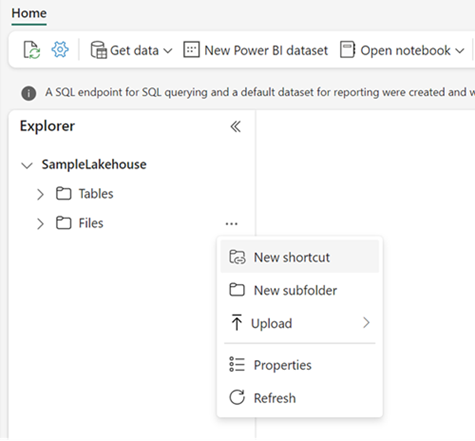Create a Google Cloud Storage (GCS) shortcut
In this article, you learn how to create a Google Cloud Storage(GCS) shortcut inside a Fabric lakehouse.
For an overview of shortcuts, see OneLake shortcuts. To create shortcuts programmatically, see OneLake shortcuts REST APIs.
Prerequisites
If you don't have a lakehouse, create one by following these steps: Creating a lakehouse with OneLake.
Ensure your chosen GCS bucket and user meet the access and authorization requirements for GCS shortcuts.
Create a shortcut
Open a lakehouse.
Right-click on a directory within the Lake view of the lakehouse.
Select New shortcut.
Select a source
Under External sources, select Google Cloud Storage.
Enter the Connection settings according to the following table:
Field Description Value URL The connection string for your GCS bucket. The bucket name is optional. https://BucketName.storage.googleapis.comhttps://storage.googleapis.comConnection Previously defined connections for the specified storage location appear in the drop-down. If no connections exist, create a new connection. Create new connection Connection name The user defined name for the connection. A name for your connection. Authentication kind Fabric uses Hash-based Message Authentication Code (HMAC) keys to access Google Cloud storage. These keys are associated with a user or service account. The account must have permission to access the data within the GCS bucket. If the bucket specific endpoint was used in the connection URL, the account must have the storage.objects.getandstorage.objects.listpermissions. If the global endpoint was used in the connection URL, the account must also have thestorage.buckets.listpermission.HMAC Key Access ID The access key associated with a user or service account. For more on creating HMAC keys, see Manage HMAC Keys. Your access key. Secret The secret for the access key. Your secret key. Select Next.
Browse to the target location for the shortcut.
If you used the global endpoint in the connection URL, all of your available buckets appear in the left navigation view. If you used a bucket specific endpoint in the connection URL, only the specified bucket and its contents appear in the navigation view.
Navigate the storage account by selecting a folder or clicking on the expansion arrow next to a folder.
In this view, you can select one or more shortcut target locations. Choose target locations by clicking the checkbox next a folder in the left navigation view.
Select Next
The review page allows you to verify all of your selections. Here you can see each shortcut that will be created. In the action column, you can click the pencil icon to edit the shortcut name. You can click the trash can icon to delete shortcut.
Select Create.
The lakehouse automatically refreshes. The shortcut appears in the left Explorer pane.





